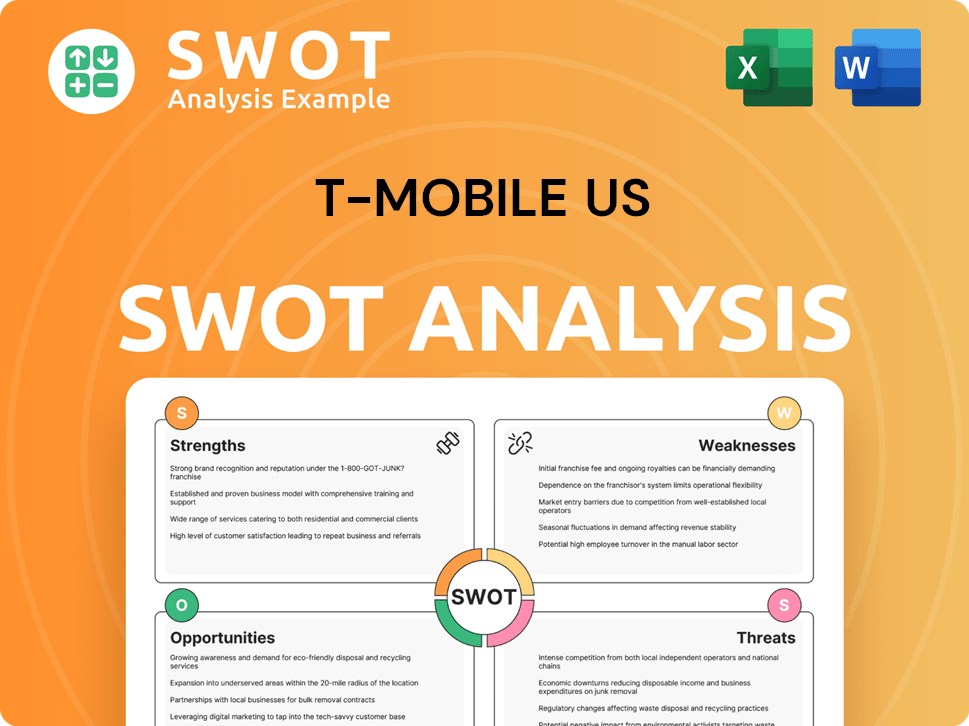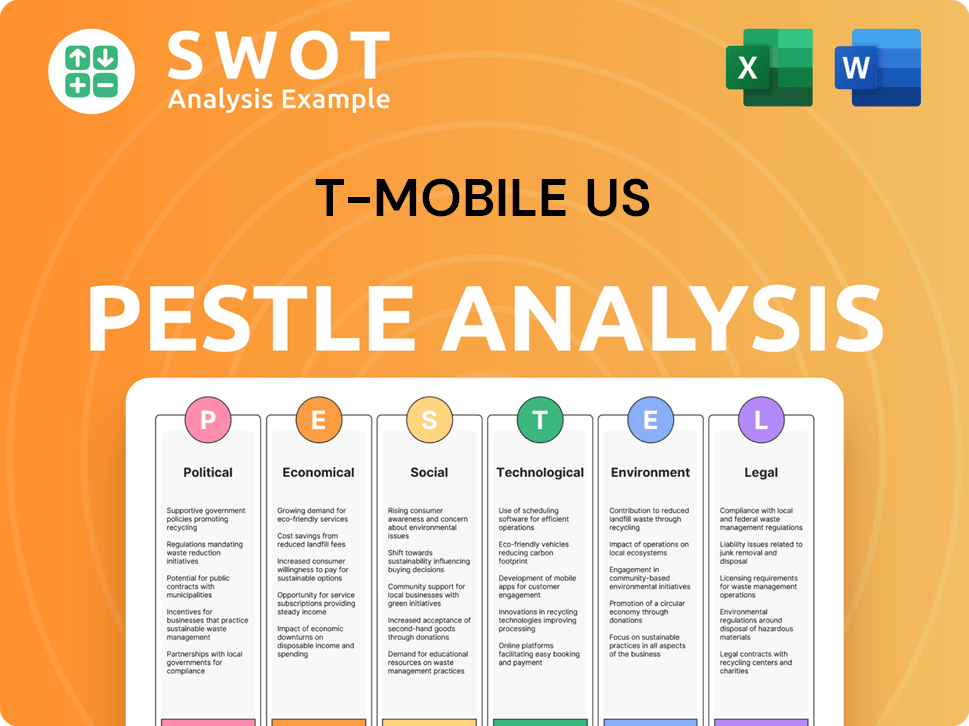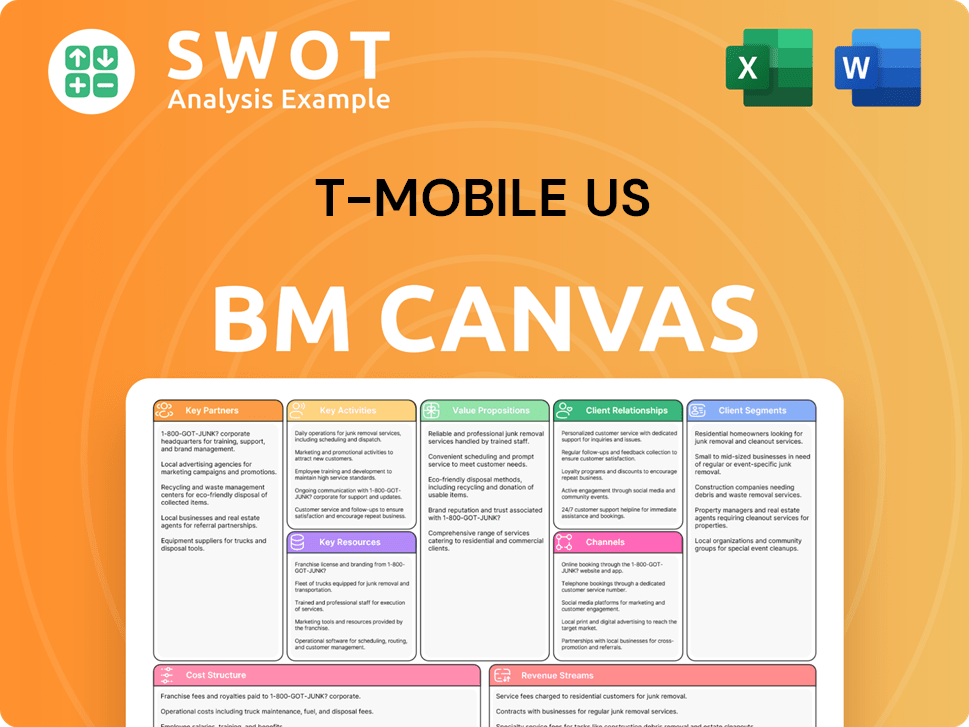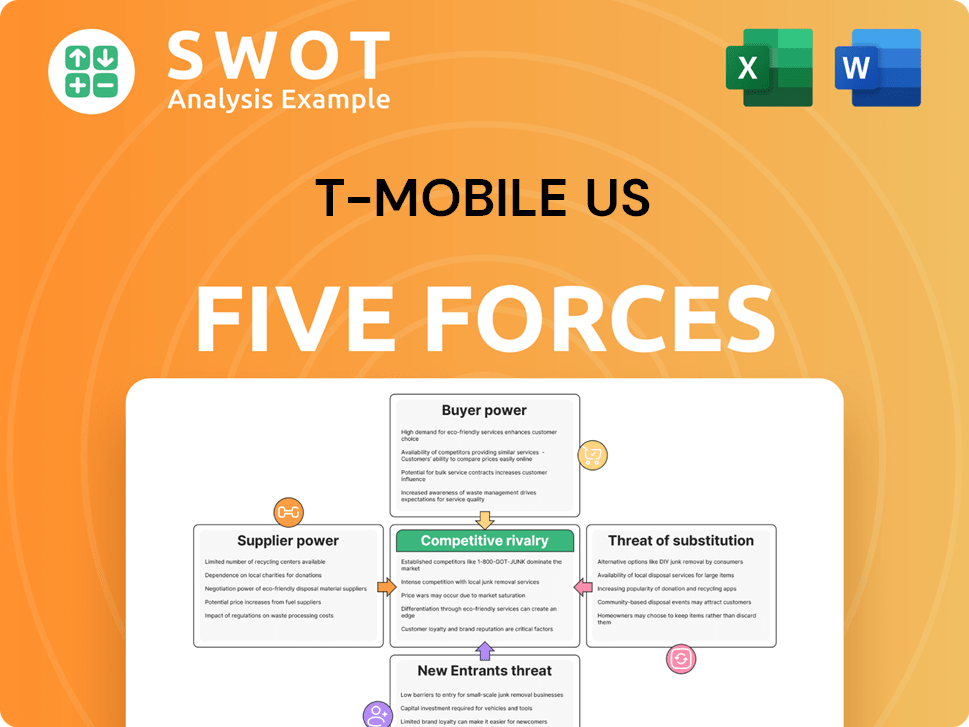T-Mobile US Bundle
Can T-Mobile US Continue Its Wireless Dominance?
The telecommunications industry is a battlefield of innovation and fierce competition, where only the most strategically agile survive. T-Mobile US, a major player in the U.S. wireless market, has consistently demonstrated its commitment to aggressive growth, especially after its merger with Sprint. This T-Mobile US SWOT Analysis will explore how this company plans to maintain its trajectory.

From its origins as VoiceStream Wireless to its current status as a leading mobile network operator, T-Mobile US has shown remarkable resilience and strategic foresight. This company analysis delves into T-Mobile US's growth strategy, examining its expansion plans, innovative services, and the impact of 5G technology on its revenue. Understanding T-Mobile US's future prospects requires a deep dive into its competitive advantages and how it navigates the ever-evolving telecommunications industry.
How Is T-Mobile US Expanding Its Reach?
T-Mobile US is actively pursuing a multi-faceted growth strategy to strengthen its market position and diversify its revenue streams within the telecommunications industry. This strategy focuses on expanding its network, particularly its 5G footprint, and exploring new service offerings like fixed wireless access (FWA). The company aims to attract new subscribers and enhance service quality for existing customers, especially in underserved areas.
A key aspect of T-Mobile's expansion involves continuous network enhancement and expansion, especially in its 5G footprint. The company is also focusing on expanding its fixed wireless access (FWA) service, which leverages its 5G network to provide home internet. Furthermore, the company is exploring new product categories and partnership strategies to capture a larger share of the business-to-business market.
The company's ongoing efforts to integrate and leverage the assets acquired from Sprint, including spectrum and retail presence, further support its expansion goals by optimizing its operational efficiency and market penetration. This approach is designed to drive long-term growth and solidify its position in the competitive landscape.
T-Mobile is significantly investing in its network infrastructure to boost its 5G coverage. In early 2024, T-Mobile announced that its 5G network covers nearly 330 million people. Its Ultra Capacity 5G reaches over 300 million people. This expansion aims to improve service quality and attract new subscribers, especially in rural areas.
T-Mobile is rapidly growing its FWA service, which provides home internet using its 5G network. At the end of 2023, the company had 5.2 million FWA subscribers, adding 522,000 in Q4 2023 alone. The company projects 7-8 million FWA subscribers by the end of 2025.
T-Mobile is focusing on expanding its enterprise business to capture a larger share of the business-to-business market. This involves tailoring solutions for various industries and leveraging its robust 5G network for enterprise-grade connectivity. The company is aiming to provide specialized services to meet the needs of businesses.
T-Mobile continues to offer wholesale wireless network access to mobile virtual network operators (MVNOs). This strategy expands its reach without direct customer acquisition costs. MVNO partnerships help T-Mobile increase its market presence and revenue streams.
T-Mobile's expansion strategy includes significant investments in 5G technology and network infrastructure to enhance its service offerings and customer reach. The company is also focusing on expanding its fixed wireless access (FWA) service, leveraging its 5G network to provide home internet, aiming to capture a larger share of the business-to-business market.
- Continuous network upgrades and expansion of 5G coverage.
- Aggressive growth in Fixed Wireless Access (FWA) subscriptions.
- Strategic partnerships and wholesale agreements to expand market reach.
- Integration of Sprint assets to optimize operational efficiency.
T-Mobile US SWOT Analysis
- Complete SWOT Breakdown
- Fully Customizable
- Editable in Excel & Word
- Professional Formatting
- Investor-Ready Format

How Does T-Mobile US Invest in Innovation?
The growth strategy of T-Mobile US is heavily influenced by its commitment to innovation and technological advancement, especially in 5G. The company has invested significantly in research and development to boost its 5G network capabilities, aiming for superior speeds and reliability. This focus on technology is central to its future prospects within the telecommunications industry.
T-Mobile's dedication to digital transformation is clear through its use of its 5G network for fixed wireless access (FWA), a key growth driver. The company's in-house development of 5G infrastructure allows for greater control over network performance and rapid deployment of new features. This approach helps maintain its competitive edge.
The company is exploring cutting-edge technologies like artificial intelligence (AI) and the Internet of Things (IoT) to enhance customer experience and create new revenue streams. Its strong 5G network provides the foundation for these technologies to flourish. This positions T-Mobile US to capitalize on future technological advancements.
T-Mobile's 5G network covers nearly 330 million people. Its faster Ultra Capacity 5G reaches over 300 million people, demonstrating a broad and expanding presence.
FWA is a significant growth area, leveraging T-Mobile's 5G network to provide internet access to homes and businesses. This service expands the company's reach beyond traditional mobile offerings.
T-Mobile's in-house development of 5G infrastructure gives it greater control over network performance. This allows for quicker deployment of new features and upgrades, enhancing its competitive position.
The company is exploring AI and IoT to improve customer experience and generate new revenue streams. These technologies are supported by its robust 5G network, setting the stage for future innovation.
T-Mobile's focus on network performance and expansion, particularly its 5G leadership, allows it to capitalize on future technological advancements. This approach is key to maintaining a competitive edge.
T-Mobile's investments in 5G and related technologies provide it with competitive advantages in the telecommunications industry. This is crucial for long-term growth potential.
T-Mobile's innovation strategy focuses on 5G network expansion, in-house infrastructure development, and the exploration of AI and IoT. These initiatives support its overall growth strategy.
- 5G Network Expansion: Continuing to increase 5G coverage and capacity.
- Fixed Wireless Access (FWA): Leveraging 5G for home and business internet services.
- AI and IoT Integration: Exploring applications to enhance customer experience and create new revenue streams.
- In-House Development: Maintaining control over network performance and feature deployment.
For more insights into the company's core values, mission, and vision, consider reading about the Mission, Vision & Core Values of T-Mobile US.
T-Mobile US PESTLE Analysis
- Covers All 6 PESTLE Categories
- No Research Needed – Save Hours of Work
- Built by Experts, Trusted by Consultants
- Instant Download, Ready to Use
- 100% Editable, Fully Customizable

What Is T-Mobile US’s Growth Forecast?
T-Mobile US has demonstrated a robust financial performance, signaling a strong foundation for its future. The company's strategic initiatives and operational efficiencies have positioned it favorably within the competitive telecommunications industry. This financial health is a key indicator of its ability to execute its growth strategy and capitalize on emerging opportunities.
For the full year 2023, T-Mobile reported service revenues of $63.2 billion, showcasing its strong revenue generation capabilities. Furthermore, the company achieved a total of 5.7 million net additions in 2023, including 3.1 million postpaid net additions, highlighting its success in attracting and retaining customers. These figures underscore the company's growth momentum and market competitiveness.
Looking ahead to 2024, T-Mobile projects continued growth, with anticipated postpaid net account additions ranging from 1.0 to 1.3 million and postpaid net customer additions between 5.0 to 5.5 million. These projections reflect the company's confidence in its ability to sustain its growth trajectory. The company also anticipates core adjusted EBITDA to be between $30.3 billion and $30.9 billion for 2024.
In 2023, T-Mobile's service revenues reached $63.2 billion. The company added a total of 5.7 million net additions, including 3.1 million postpaid net additions. This performance highlights the company's strong financial health and market position.
T-Mobile anticipates postpaid net account additions of 1.0 to 1.3 million and postpaid net customer additions of 5.0 to 5.5 million in 2024. Core adjusted EBITDA is projected to be between $30.3 billion and $30.9 billion for the same year, indicating continued growth.
T-Mobile is focused on expanding its 5G network and fixed wireless access (FWA) services. The company expects FWA subscribers to reach 7-8 million by the end of 2025. This expansion is crucial for its long-term growth.
Capital expenditures for 2024 are projected to be between $13.2 billion and $13.6 billion. These investments are essential for maintaining and improving network infrastructure, supporting future growth. These investments are vital for the company's continued success.
T-Mobile's financial outlook is underpinned by its successful integration of Sprint and its continued expansion of its 5G network and fixed wireless access (FWA) services. The company's strategic investments and customer acquisition strategies are designed to drive sustainable growth. For a deeper understanding of T-Mobile's journey, consider reading about the Brief History of T-Mobile US.
- Service revenues of $63.2 billion in 2023.
- Total net additions of 5.7 million in 2023.
- Postpaid net customer additions of 5.0 to 5.5 million projected for 2024.
- Core adjusted EBITDA between $30.3 billion and $30.9 billion expected in 2024.
T-Mobile US Business Model Canvas
- Complete 9-Block Business Model Canvas
- Effortlessly Communicate Your Business Strategy
- Investor-Ready BMC Format
- 100% Editable and Customizable
- Clear and Structured Layout

What Risks Could Slow T-Mobile US’s Growth?
The future of T-Mobile US, while promising, is intertwined with several potential risks and obstacles. These challenges could impact the company's growth strategy and its ability to maintain its competitive edge in the telecommunications industry. Understanding these risks is crucial for assessing T-Mobile US's long-term growth potential.
Intense competition in the mobile network operator market, particularly from AT&T and Verizon, poses a significant threat. Regulatory changes, technological disruptions, and supply chain vulnerabilities further complicate the landscape. Addressing these issues proactively is vital for T-Mobile US to achieve its strategic objectives and maintain its strong financial performance review.
T-Mobile US's ability to navigate these challenges will determine its success in the coming years. The company must continuously adapt and innovate to stay ahead in a rapidly evolving market. A detailed T-Mobile US company analysis reveals the importance of these factors.
The telecommunications industry is fiercely competitive, with AT&T and Verizon constantly striving for market share. This competition can lead to pricing wars and increased customer churn, affecting T-Mobile US's revenue. The Competitors Landscape of T-Mobile US highlights the intensity of this rivalry.
Regulatory changes, including spectrum allocation and network neutrality, pose risks. Adverse decisions could limit operational flexibility or increase compliance costs. These changes can significantly impact T-Mobile US's ability to expand its 5G coverage and offer innovative services.
The rapid evolution of wireless technologies could disrupt existing business models. Advancements in satellite internet or other alternative connectivity solutions could present future competition. T-Mobile US must continuously invest in 5G technology and explore new technologies to stay ahead.
Supply chain issues, especially for network equipment and devices, can delay network expansion. These delays could affect customer satisfaction and growth targets. Managing supply chain risks is crucial for T-Mobile US's expansion into rural areas and other strategic initiatives.
Increasing cybersecurity threats pose a risk to customer data and brand reputation. Breaches could lead to significant financial and reputational damage. T-Mobile US must invest in robust cybersecurity measures to protect its customer base.
Managing vast amounts of customer data securely is essential to maintain customer trust. Data breaches and privacy violations can erode customer confidence. T-Mobile US must prioritize data security and privacy to maintain its competitive advantages.
T-Mobile US addresses these risks through diversification, robust risk management, and proactive strategies. The expansion into fixed wireless access helps mitigate reliance on traditional mobile services. The company also employs scenario planning to prepare for market and regulatory shifts, demonstrating its commitment to long-term growth potential.
As of Q1 2024, T-Mobile US reported over 95 million customers, demonstrating its continued growth. The company's investment in 5G infrastructure is ongoing, with plans to expand coverage further. However, the competitive landscape remains intense, with AT&T and Verizon also investing heavily in their networks. The company is also focused on customer acquisition strategies.
T-Mobile US Porter's Five Forces Analysis
- Covers All 5 Competitive Forces in Detail
- Structured for Consultants, Students, and Founders
- 100% Editable in Microsoft Word & Excel
- Instant Digital Download – Use Immediately
- Compatible with Mac & PC – Fully Unlocked

Related Blogs
- What are Mission Vision & Core Values of T-Mobile US Company?
- What is Competitive Landscape of T-Mobile US Company?
- How Does T-Mobile US Company Work?
- What is Sales and Marketing Strategy of T-Mobile US Company?
- What is Brief History of T-Mobile US Company?
- Who Owns T-Mobile US Company?
- What is Customer Demographics and Target Market of T-Mobile US Company?
Disclaimer
All information, articles, and product details provided on this website are for general informational and educational purposes only. We do not claim any ownership over, nor do we intend to infringe upon, any trademarks, copyrights, logos, brand names, or other intellectual property mentioned or depicted on this site. Such intellectual property remains the property of its respective owners, and any references here are made solely for identification or informational purposes, without implying any affiliation, endorsement, or partnership.
We make no representations or warranties, express or implied, regarding the accuracy, completeness, or suitability of any content or products presented. Nothing on this website should be construed as legal, tax, investment, financial, medical, or other professional advice. In addition, no part of this site—including articles or product references—constitutes a solicitation, recommendation, endorsement, advertisement, or offer to buy or sell any securities, franchises, or other financial instruments, particularly in jurisdictions where such activity would be unlawful.
All content is of a general nature and may not address the specific circumstances of any individual or entity. It is not a substitute for professional advice or services. Any actions you take based on the information provided here are strictly at your own risk. You accept full responsibility for any decisions or outcomes arising from your use of this website and agree to release us from any liability in connection with your use of, or reliance upon, the content or products found herein.